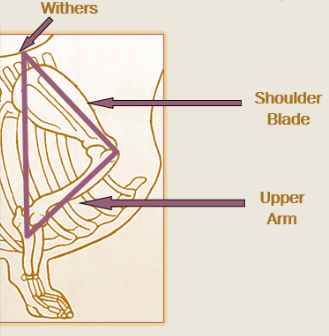What Is A Correct Dachshund Front
One of the distinguishing features of the Dachshund, and an important component of the breed
type, is the structure of the Dachshund front.
Unfortunately, very few correct fronts are seen in today's conformation ring.
One must always remember that the Dachshund was designed and bred to hunt badgers.
First and foremost, the Dachshund is a hunting dog. His unique body type was developed specifically to hunt badgers underground. The Dachshund's strong hunting instincts make him an excellent trailing dog as well. He should always exhibit the structure and temperament traits that are necessary for him to perform effectively below as well as above ground.
Importance of a Proper Front
For the Dachshund to accomplish the work that he was bred to do, a proper front is essential.
When working, it is the front of the dog that takes the most abuse, which is why a correctly
put-together front is so important for the dog's endurance in the field.
The Dachshund front is even more specialized to enable him to work effectively underground.
Key Features of the Dachshund Front
Strong Shoulders
Essential for digging and maneuvering in tight spaces.
Deep Chest
Provides ample space for the heart and lungs, which is crucial for stamina.
Powerful Forelimbs
Designed to endure the rigors of digging and navigating through burrows.
Understanding these structural elements helps to appreciate the Dachshund's abilities and the importance of maintaining breed standards. As enthusiasts and breeders, it is crucial to recognize and strive for these features to preserve the Dachshund's functional and historical integrity. There are several key points to remember regarding the Dachshund front as it is described in the standard.

PROFILE VIEW
Breastbone (Forechest)
When viewed in profile, the breastbone is very prominent in front. This prominence creates depressions or “dimples” on either side of the breastbone that are quite apparent.
Chest Shape
Viewed from the front, the chest appears oval and extends downward to the mid-point of the forearm. The keel merges gradually into the line of the abdomen and extends well beyond the front legs.
SHOULDER ASSEMBLY
Shoulder Bones
The bones of the shoulder are long, broad, well laid back, and closely fitted at the withers. Ideally, the upper arm is the same length as the shoulder blade and is placed at a right angle to it.
FOREARM STRUCTURE
Forearm Shape
The forearm is short and slightly curved inward. As the breed standard states, “the joints between the forearms and the feet (wrists) are closer together than the shoulder joints, so that the front does not appear absolutely straight.”
CREATING A FUNCTIONAL FRONT
Forming Parentheses
The inclined shoulder blades, upper arms, and curved forearms form parentheses that enclose the ribcage. This structure not only supports the Dachshund's distinctive appearance but also enhances its functionality, allowing for effective movement and endurance in the field.
Summary
The Dachshund's front is a masterpiece of evolutionary design, perfectly suited to its role
as a burrow hunter.
From the prominent breastbone to the specialized shoulder and forearm structure, every aspect
of the front is crafted to ensure the breed can perform its hunting duties efficiently.
Understanding and maintaining these standards is essential for breeders and enthusiasts
dedicated to preserving the Dachshund's unique capabilities and heritage.
Challenges in Recognizing a Correct Front
Lack of Forechest and Straight Shoulders
Many exhibitors and breeders may not recognize a correct front because they don't often see it in the conformation ring. Too many Dachshunds in the show ring today lack forechest and have straight shoulders.
Incorrect Profile View
When viewed in profile, Dachshunds with these faults stand with the front legs under the neck rather than under the withers. The neck appears to meet the withers at a 90-degree angle instead of the slightly arched neck flowing smoothly into the shoulders. The keel stops abruptly or just slightly behind the front legs rather than extending well beyond them.
Importance of Correct Front Assembly
Maintaining the correct front assembly is crucial for preserving the Dachshund's ability to perform its historical role as a burrow hunter. A proper front ensures the dog can move efficiently and endure the physical demands of hunting. Breeders and exhibitors should strive to recognize and breed for these correct features to uphold the breed's functional and aesthetic standards.
MOVEMENT AND CONSTRUCTION
Dachshunds who lack proper construction in these areas may present a pleasing profile with a nice level topline. However, their lack of proper construction becomes apparent when they move.
PROPER MOVEMENT
Fluid and Smooth Movement
Proper Dachshund movement should be fluid and smooth. The forelegs should reach well forward without much lift. A correct shoulder assembly and well-fitted elbows permit a long, free stride.
Feet Alignment
Feet must travel with no tendency to swing out, cross over, or interfere with each other. Short, choppy movement, a rolling or high-stepping gait, and feet that are too close or overly wide coming or going are incorrect.
Breeding for Correct Structure
The correct Dachshund front is probably the most difficult part of the Dachshund structure to understand and to consistently breed. Breeders and exhibitors in all types of competition (conformation and performance events) need to be vigilant in evaluating their dogs and producers and strive to evaluate the fronts on their dogs and the fronts they produce.